 Tonga is unique among Pacific nations. It never completely lost its indigenous governance. The island groups were united into a Polynesian kingdom in 1845, and became a constitutional monarchy in 1875. Though it was a British protectorate for 70 years, Tonga remains the only monarchy in the Pacific. Its culture very much intact, it's a fascinating place to visit. The International Dateline juts around this island kingdom making it one of the first countries in the world to see the sunrise of a new day.
Tonga is unique among Pacific nations. It never completely lost its indigenous governance. The island groups were united into a Polynesian kingdom in 1845, and became a constitutional monarchy in 1875. Though it was a British protectorate for 70 years, Tonga remains the only monarchy in the Pacific. Its culture very much intact, it's a fascinating place to visit. The International Dateline juts around this island kingdom making it one of the first countries in the world to see the sunrise of a new day.
The archipelago of Tonga, dubbed the “Friendly Islands” by Captain James Cook, consists of 169 islands, with only 36 inhabited. There are four main island groups including the mostly low-lying and southernmost Tongatapu group; the volcanic and coral Ha'apai group; the flat coral islands of the Vava'u group; and the volcanic Niuas group in the far north. We visited three of the four groups.

Did you ever watch the adventure series in the late 1950's created by James Michener entitled Adventures in Paradise? When we arrived in Neiafu, the largest town in the Vava'u group, that series that we'd watched as kids came to mind. Neiafu is a little South Pacific seaport, hustling and bustling with local commerce. We picked up a mooring in the well-protected little harbor and enjoyed its sights, smells and sounds for more than a week. The waterfront is primarily lined with restaurants, shops and yacht charter companies owned by ex-pats. There are lots of little hotels and a reasonable tourist infrastructure. It's easy to schedule dives, island tours and Tongan feasts.
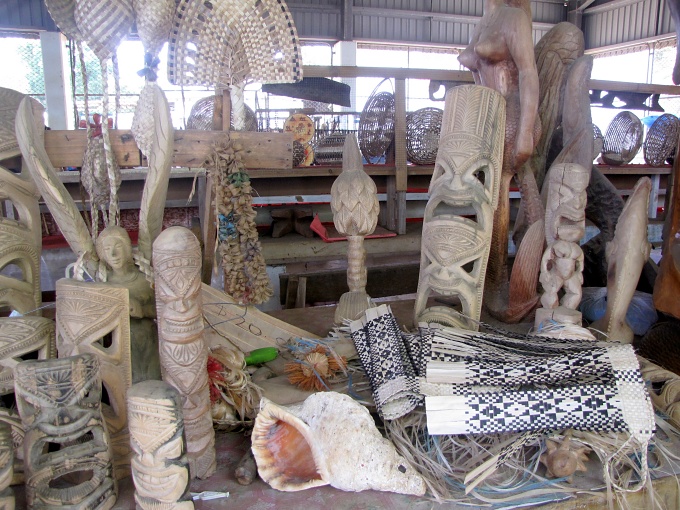
The fresh market and crafts market are excellent here. Smiling, welcoming people pitched their fresh veggies and exotic fruits to us at bargain prices. The crafts market adjoining the fresh market was open daily and offered some of the most unique, high quality and inexpensive crafts we'd seen in the South Pacific, especially basketry, tapa, carvings and jewelry.
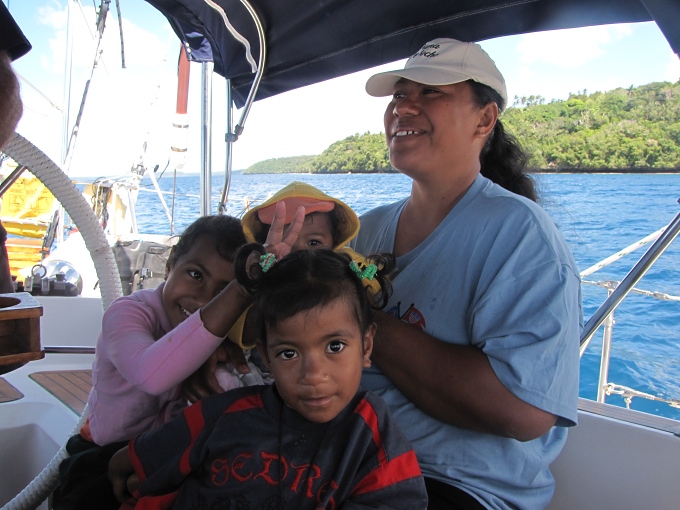
Though we enjoyed Neiafu, it was quite commercial. After over a week of “civilization”, we opted to head out in the Vava'u group and do a bit of exploring. We didn't get far before we found a place we liked … Matamaka ... and, as usual, we ended up staying longer than planned. The reason for staying was not the scenic vistas nor the snorkeling or diving … though all were great. We stayed because of the people and our ability to interact with them. We met Fa'aki, her husband, Ben and their six kids and we just bonded. Fa'aki's excellent English allowed us to learn more about the Tongan culture and their way of life.

David's engineering background came in very handy. First, he fixed solar panels for the school teacher; then for the minister. Then there were generators and more solar panels to fix. Folks were coming by horseback from the other side of the island to enlist David's aid. Time to call in the troops! We contacted “Yohelah” and “Gannet”, good friends and fellow SSCA members, and invited them to come for a Tongan feast ... and oh, by the way, come prepared to help with the repairs.
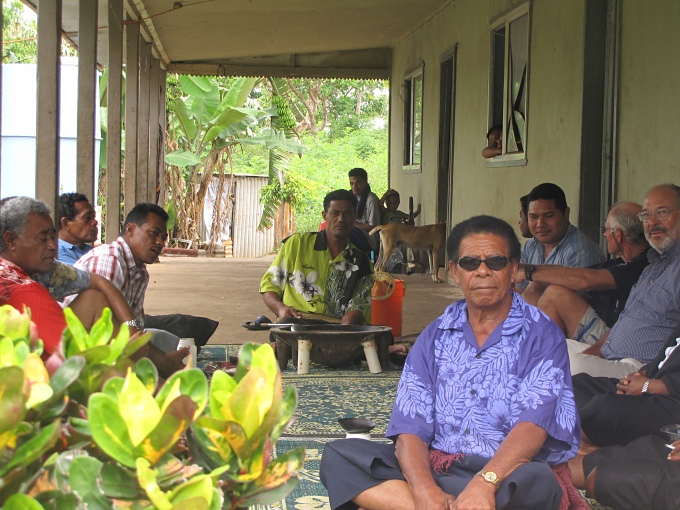
The feast was held in honor of Roxanne's (Fa'aki's oldest daughter) graduation from elementary school and it was splendid. The men had been invited to a kava circle earlier in the morning and were definitely mellow when it was time to eat. We contributed some baked goods on request (no conventional ovens other than underground umus on the island) and were treated as honored guests. We were at a loss as to proper etiquette although no one seemed to mind. Sitting cross-legged the way the natives do was not physically possible for us. We sat on the ground mats and managed uncomfortably, listening to one speech after another. Finally, the feast … roast suckling pig, veggies, all sorts of local delicacies and Fanta orange soda.
Our men earned their feast! They spent two subsequent very full days ashore making repairs. The final count: 30 solar panels, 4 generators, a telephone, a digital camera, 2 VCR's, 3 TVs, 1 DVD player, a weed whacker and who knows what else...we lost count. But it was truly a community affair. People were queued up. Everyone watched intently as “the doctors” diagnosed problems. If it was fixable, a collective sigh went up from the crowd with smiles and thumbs up signs. If not, “oh well” and they moved on to the next repair. We were paid in bananas, lettuce, coconuts and genuine smiles of thanks.
While the men worked, Fa'aki took the women on a village tour with stops to admire weaving, tapa-making, gardening and learn more about Tongan culture. It's a very small village and it was easy to keep track of the men's progress. If we didn't see them, we certainly heard where they were and what project they were currently working on. Without a doubt, the time spent in Matamaka was the highlight of our visit to Tonga.

We spent a few days in the Hapa'ai group on the way south, but could have spent a month. Anchorages here were empty. Most islands were uninhabited. We could walk the beaches for miles shell collecting, bird watching and enjoying the peace and quiet.

Tonga's “big smoke” is the capital city of Nuku'alofa in the Tongatapu group. After the pristine, secluded anchorages of Hapa'ai, we anchored with about 60 other boats off Big Mama's Bar & Restaurant at Pangaimotu. What a contrast! Though Big Mama caters to cruisers offering all the amenities a sailor could want, she also owns Pangaimotu Island Resorts with fales (traditional thatched-roof huts) for rent which we heard were great. Daily ferries run across the channel into the city or you can take your dinghy.
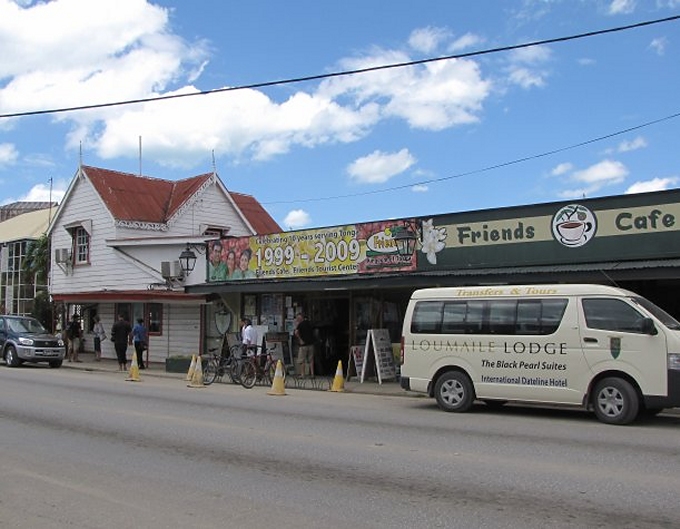
Nuku'alofa offers supermarkets and fresh markets and lots of small shops. You might not find everything in one place, but with enough searching around, you'll find most things you need for provisions. There are beaches, resorts and tourist attractions galore here. The blend of strong, traditional Tongan culture with the modern day world is very noticeable everywhere you go. Fakatonga is an important expression to learn...it means “the Tongan way” and for better or worse, it's how things are done in Tonga.
If you go:
Guides: Moorings Cruising Guide to Vava'u Tonga (free pdf download) and its associated numbered chart.
A Yachtsman's Guide to the Hapa'ai Group
Kingdom of Tonga by Phil Creegen
Sailingbird's Guide to the Kingdom of Tonga .
.
Our land guide was Lonely Planet Tonga .
.
To save money, Lonely Planet South Pacific might do just as well.
might do just as well.

We highly recommend Making Sense of Tonga , by Mary McCoy and Drew Havea. It's an excellent introduction to Tongan culture and etiquette.
, by Mary McCoy and Drew Havea. It's an excellent introduction to Tongan culture and etiquette.
Charts: Navionics electronic charts were off by nearly ½ mile in some locations as were the paper charts we had. We recommend no navigation at night while in the island groups and a good watch while navigating during the day.
Currency: Tongan pa'anga (TOP) though the Tongans refer to them as dollars. TOP $1=US 0.48.
Time: GMT +13; one of the first countries in the world to greet each new day.
Neiafu, Vava'u 18S39.85 / 173W58.92 (Mooring in Neiafu Harbor)
Anchorage/Moorings: Moorings are available at TOP $15/night no matter what company owns them. Pink moorings belong to The Moorings and are reserved for their charter customers, otherwise any free mooring with a number can be picked up and used. Call the “owner” on the VHF channel marked on the mooring ball and pay them when you're leaving. It's a pretty informal system.
Port Guide: In Neiafu, pick up a current, free copy of Vava'u Marine Guide from Tropical Tease or Tropicana as soon as you arrive. This guide contains all the information you'll need for getting around Neiafu and finding needed supplies and services including fuel, propane, laundry, restaurants, sightseeing, etc.
Dinghy dock: Tie up at Aquarium or the public dinghy dock behind the little breakwater near the Custom's Dock.
Tourist Info Center on the main street provides some basic brochures and has a crafts center which offered some different products than those seen in the public market. The prices were quite reasonable.
What to do do/see:
Whale watching in season (Aug/Sept especially)
Fishing
Snorkeling/diving
Cruising at its best in paradise.
Inland hiking, bicycle, car & motorcycle hire available

Tongan feasts
PIG 89.3 FM – the local “ex-pat” radio station with easy-listening music
Cruiser's Morning Info Net – 0830 daily on Channel 26 VHF; weather/tides, general information, local happenings
Internet – While we were in Neiafu, we had free wifi on the boat compliments of Aquarium. Otherwise, there is internet available at Aquarium and Tropicana restaurants.
ATMs – Yup...two of them. ANZ and Westpac Banks. Both are on the main street and they usually dispense money. (This is Tonga, remember. Not everything works all the time!)
Matamaka 18S42.46 / 174W07.75 – 45' (good holding in sand)
Services – None; you can probably pick up some fresh lettuce, kumara (sweet potato),coconuts, fish/lobster from the villagers for purchase or trade. There is an old, dilapidated wharf, but it's easier to beach your dinghy ashore.
Fa'aki's house is near the wharf. If she's there, ask her for a village tour. She speaks excellent English.
Hunga – 18S41.56 / 174W07.75 – 70' (good holding in sand)
There's a small village here. Check in with them as a courtesy if you plan to stay. The narrow entrance to Hunga is daunting...the proverbial “between a rock and a hard place”. We'd suggest checking out the Moorings guide or getting local knowledge before entering.
Pretty little beaches here and lovely scenery.
Blue Lagoon – 18S42.72 / 174W08.38
Gorgeous anchorage - entrance through the reef can be tricky, but it's pretty straightforward with good visibility. No services. We used it as a jump-off point for heading to Hapa'ai.
Ha'apai Group

Nukunamo Island - 19S42.71 / 174W17.01 – (43' good holding, sand)
Services – None; this is just a small, uninhabited island. Good shelling and beachcombing. We learned in Nuku'alofa that there were plans to develop this island into a resort. See it while it's still pristine!
Tofanga – 19S57.45 / 174W28.35
Services – None; this is just a small, uninhabited island. Good shelling and beachcombing
Tongatapu Pangaimotu- 21S07.51 / 175.09.82 – (75' good holding)
Anchorage off Big Mama's. Big Mama's Bar and Restaurant – everything you'd expect in a South Sea's island bar/restaurant...sand floors, cold beer, friendly people, good food. You can also tie up med-moor style at the inner harbor in Nuka'alofa. Fees apply.
Supermarkets/provisioning - The Talamahu Market is a huge fresh/crafts market; other smaller supermarkets are available with varied offerings. Don't expect much and you won't be disappointed.
ATMs – Westpac and ANZ both available on Taufa'ahau
What to do do/see
Walking tour of the town
Archeological sites
Never ending offerings of cultural shows, feasts & dancing
Snorkeling, diving
Good collectible stamps from the post office.







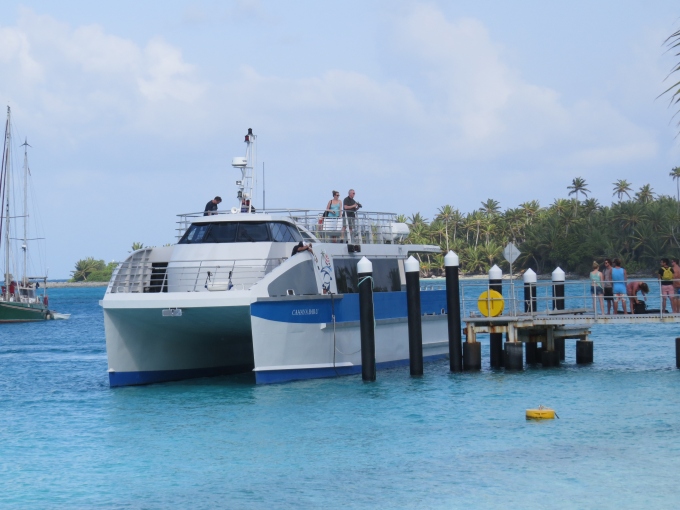





















 .
. .
. might do just as well.
might do just as well.
 , by Mary McCoy and Drew Havea. It's an excellent introduction to Tongan culture and etiquette.
, by Mary McCoy and Drew Havea. It's an excellent introduction to Tongan culture and etiquette.
